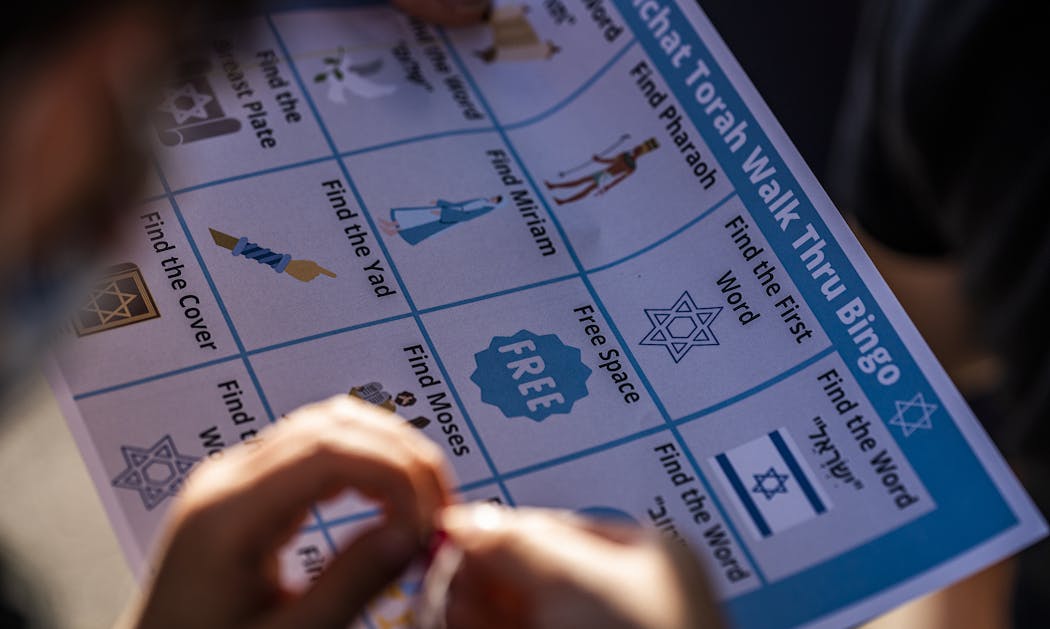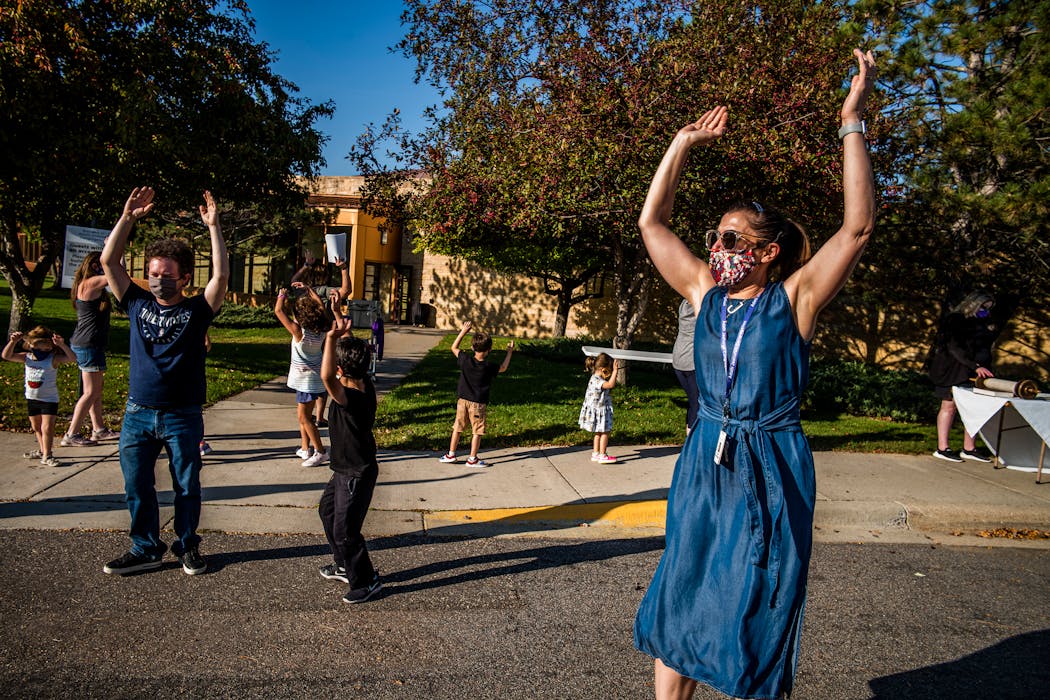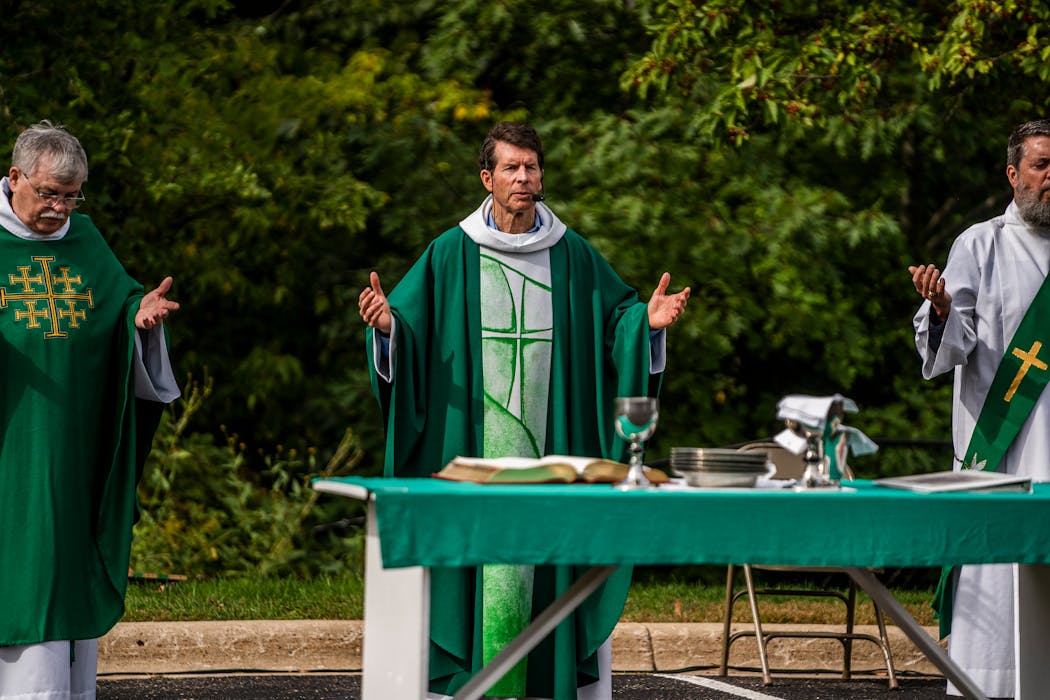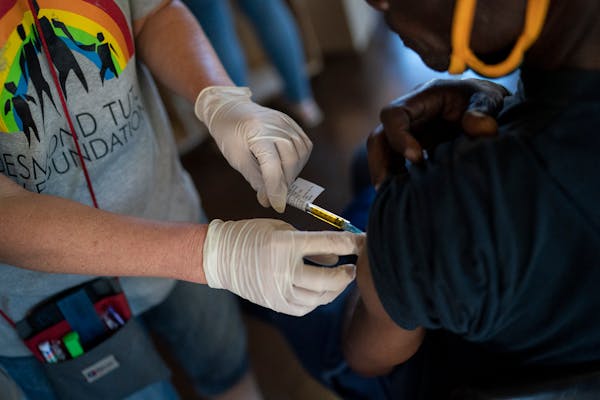When COVID-19 restrictions forced the Rev. Bob White to abruptly shut down his church in Victoria in the spring of 2020, staffers scrambled to launch livestreaming masses online and, on a whim, added an outdoor Sunday mass in the parking lot.
The Facebook masses have ended, but outdoor worship is now a part of life at St. Victoria Catholic Church. At 10:45 a.m. on Sunday, White celebrates mass in the tree-lined parking lot, presiding over a sea of the faithful in lawn chairs and parked cars at what has become the parish's most popular liturgy.
It's just one example of how innovations sparked by COVID restrictions have gone mainstream, changing the religious landscape across Minnesota and around the nation.
St. Victoria's, for example, will continue livestreaming baptisms and funerals on request for loved ones unable to attend. White will keep doing his weekly talk show on Facebook to stay in touch with members, and the church will continue to promote digital donations instead of weekly envelopes dropped in an usher's basket.
"Why didn't we think of this before?" White said. "I'm surprised by how so much of this is now part of our culture. It's shifting the way we connect with people, reaching people we otherwise would not reach."
Religious leaders were reeling in March of last year when they suddenly had to lock the doors and pivot to socially distanced alternatives for worship, religious education and other programs. While challenges persist — particularly how to draw the faithful back inside — clergy now say that many of the new ideas have resulted in efficiencies, leaps in technological know-how, and popular adaptations of ancient traditions.
Children with schedules that conflict with religious education class can join from home computers. Congregation members unable to leave home can celebrate holidays virtually with their pastors and even partake in communion-to-go.
Clergy who had spent hours crafting lengthy sermons have found brevity a blessing, and outdoor-lovers revel in open-air worship and events.
It's been a sharp learning curve for religious leaders. But once the video cameras were purchased, technology mastered and outdoor spaces reconfigured, they got more comfortable and creative.
"All of us are rethinking, evaluating, which [adaptations] will go forward," said the Rev. David Lose, senior pastor at Mount Olivet Lutheran Church in Minneapolis. "I think the church, like a lot of institutions during the pandemic, learned they could connect with people in new and different ways."
A work in progress
A nationwide survey of 776 clergy conducted last year by Luther Seminary in St. Paul asked pastors what they considered the "most promising innovations" sparked by the pandemic. Eighty percent said online worship and 54% said groups such as classes and fellowship on Zoom. More than 40% liked fresh donation strategies, including digital. About a third embraced distributing religious articles to members — such as candles, prayer texts and even altar cloths — to "do church" at home.
"There's a sense that, as we put our lives back together again, congregation leaders don't want to do the same thing anymore," said Terri Elton, a Luther Seminary professor involved in the research.
That "same thing" is being reworked in rituals and programs across faith traditions.
Imam Makram El-Amin said his small home office now is equipped with a video camera, tripod and lighting used for creating short prayer videos posted on Instagram. He's making two-minute audio recordings to send to congregants via voice mail as part of his mosque's greatly expanded social media presence.
"I had to adjust and trust," said El-Amin, of Masjid An-Nur in Minneapolis. "Before, I never had any of this."
Mount Zion Temple in St. Paul launched a "shofar from the rooftop" ceremony to give members an outdoor option for Rosh Hashana involving the blowing of the shofar, or ram's horn trumpet. Adath Jeshurun Congregation in Minnetonka purchased a large tent and rented another to shelter its children's programs behind the synagogue for the high holidays this fall, a change that got the thumbs-up from families.
"We're all wrestling with this, trying to recognize how worship will be going forward," said Rabbi Adam Stock Spilker of Mount Zion. "It's a work in progress. What's most difficult is the continual unknown."
Outside — and online
On a recent Sunday morning, a steady stream of folks toting lawn chairs poured into St. Victoria's parking lot. White, wearing bright green vestments, mingled with the crowd accompanied by his golden retriever, Arlo. The service, he said, allows him to interact casually with his congregation and has become an unexpected outreach opportunity for new visitors.
Joy and Chris Fischer were among those seated in the crowd, enjoying the picture-perfect autumn day. The couple said they prefer outdoor worship because it connects them to God's natural world. Chris Fischer recalled a sunset mass "that was more beautiful than any cathedral."
"To be honest, the only reason I came here today is because it's outside," said Joy Fischer. "Sometimes the Catholic Church can feel rigid. This feels more authentic and organic — more human."
Such comments reflect why drive-in worship and outdoor rituals are likely to be a permanent part of Minnesota's religious life. They attract not just outdoorsy people, but those with mobility problems and those who just like something different and pandemic-safe.
Social media outreach and online worship or prayers also are expected to become permanent features for many faith groups. COVID adaptations put a spotlight on fundraising, staffing and worship efficiencies using technology.
Churches such as St. Joseph the Worker in Maple Grove, for example, are recording weddings, funerals and baptisms — at the request of families — and posting them on their YouTube channels. St. Victoria's posts them at a private space on the church website, so loved ones can view them any time.
The Cathedral of St. Paul has leapt into fundraising technology, including using QR codes in the church bulletin to facilitate donations.
Orthodox Jews cannot livestream services on shabbat and holidays because of religious restrictions. But communities such as Darchei Noam in St. Louis Park, an Orthodox congregation, have made online prayer services available during the week.
"That never would have occurred to us to do before," said Rabbi Max Davis of Darchei Noam. "We're planning to continue that for now. All weekday adult ed classes are online or hybrid."
In fact, faith groups overwhelmingly are creating hybrid options as a bridge to reach both those who have grown comfortable online and those who still crave human contact.
"For everything we do, we ask, 'Is this program that we've done for years going to be online, in person or hybrid?' " said Rabbi Harold Kravitz of Adath Jeshurun Congregation. "We're learning how to teach hybrid."
Many of the digital alternatives have been surprisingly successful, enabling people from around the world as well as across town to participate in online worship and classes. But keeping the at-home people in the fold, even as they're rarely seen at worship in person, is something faith leaders are grappling with now and will be into the future.
"What if we are engaging more people but the church is empty?" asked Lose. "We averaged 3,000 in-person worshippers on Sundays, an estimated 6,000 views online. We don't want to lose that, but for the congregation, how will it impact them?"
Imam Asad Zaman, executive director of the Muslim American Society of Minnesota, said he embraces technology but worries about its effect on congregation relationships.
"If you have 15 people on Zoom, only one conversation can take place at a time," said Zaman. "There are no side conversations that build rapport. The human capital that was built, you can only coast on it for so long."
Even so, it's clear to many that the pre-pandemic norm of in-person worship and programs at a religious building has forever changed.
"We won't ever go back to where we were," said El-Amin. "This is the world right now."

University of Minnesota police arrest 9 after pro-Palestinian encampment set up on campus
2 dead in Lino Lakes, no known threat to public, police say
Teen charged with murder in deadly St. Paul shooting last month





